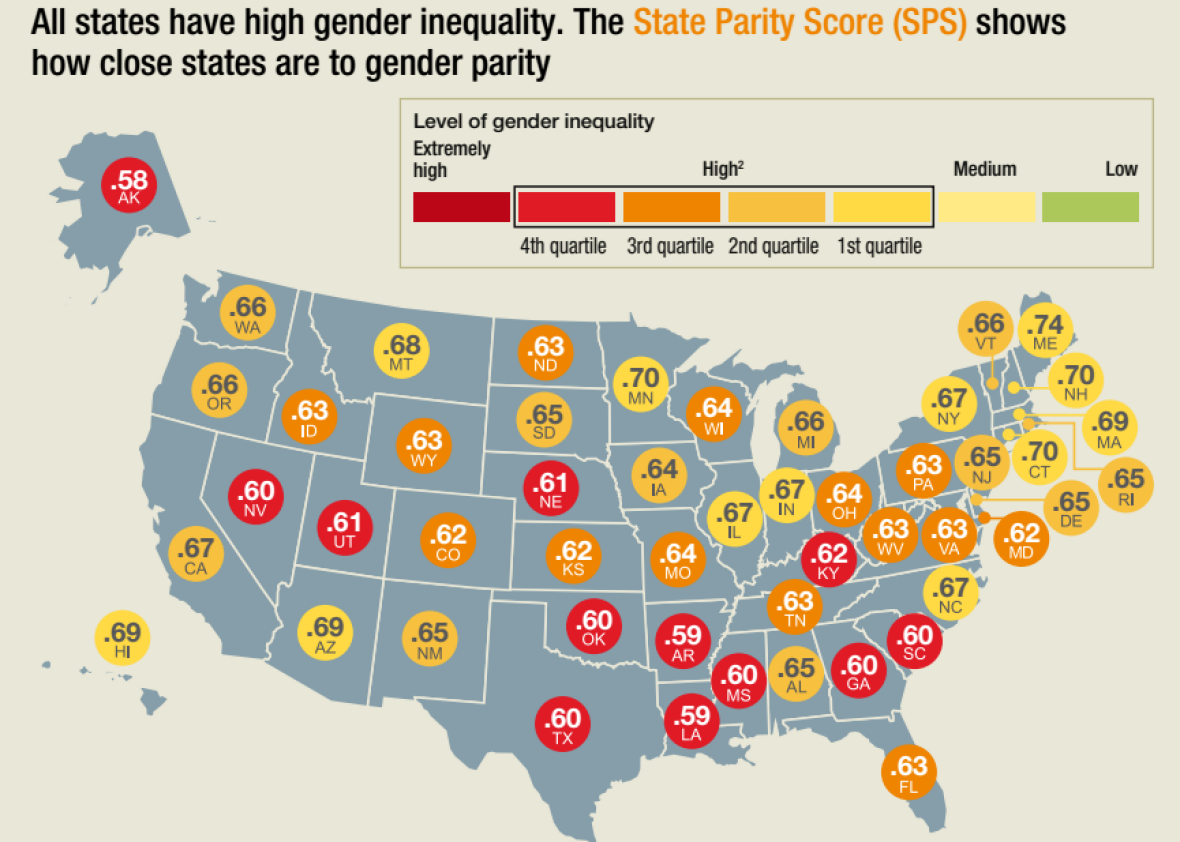The U.S. could increase its GDP by trillions if it fixed gender inequality, according to a new report from the McKinsey Global Institute. In a paper released on Thursday, MGI reported that poor performance in six of 10 major indicators of gender equity, including violence against women and business leadership representation, are keeping the country from reaching its economic potential.
By taking the steps necessary to increase women’s participation in the workforce, reduce the gender gap in work hours (women hold more part-time jobs and fewer full-time jobs than men), and hire women in the economy’s most productive sectors, the U.S. could add up to $4.3 trillion to its economy by 2025, MGI says.
That’s an admittedly high estimate that assumes full gender equity in all areas, which we probably can’t expect by 2025 no matter how many mediocre men we stomp under our biz-casual pumps on our way up the corporate ladder. But even if, for the next decade, every state just matched the best respective state’s performance over the last decade in meeting each of those three goals, the country’s GDP would rise by $2.1 trillion by 2025. That’s 10 percent better than our usual rate of growth, MGI says, an expansion equivalent to adding another entire state of Texas to our economy. Each individual state and city would see a GDP jump of at least 5 percent—and up to 13 percent—by ramping up gender equity to that level. MGI estimates that getting there will take $475 billion in additional capital investment to create 6.4 million jobs. That seems unlikely to materialize, but the growth opportunity is there.
Thursday’s report also ranks every U.S. state on gender parity, as measured by 10 indicators: women’s participation in the work force, the types of jobs women hold, the number of women in higher education, the maternal mortality rate, the number of women who hold leadership positions in their work, how many hours women spend on unpaid work, the number of single mothers, the teen pregnancy rate, women’s representation in politics, and rates of violence against women.
MGI found that the U.S. rated decently on the first four indicators, but registered high or extremely high levels of inequality on the latter six. There are 66 women in U.S. business leadership positions for every 100 men, for instance, and women do nearly twice the amount of unpaid care-related work that men do. New England fared well: Maine, New Hampshire, and Connecticut, in addition to Minnesota, had the country’s highest levels of gender equity. They were followed by Hawaii, Arizona, Montana, North Carolina, Illinois, Indiana, and New York. States in the South fared worst: Louisiana, Arkansas, Mississippi, Alaska, Nevada, Texas, South Carolina, Georgia, and Oklahoma came in as the least equitable places for women.

The country is already showing some improvement in at least one of these areas. The teen pregnancy rate is falling fast, largely thanks to improvements in sex education and contraception. But one of the most appalling sections of the MGI report deals with violence against women, which harms women’s economic advancement through lost wages and productivity in addition to causing physical and emotional damage. MGI’s analysts found that one out of every three U.S. women is a survivor of intimate partner violence, and half of U.S. women have survived sexual violence of some kind. These rates align with many other countries in the world, but virtually none of our developmental peers, Fortune reports.
The most important takeaway from the report is that social and economic equality are interdependent goals. MGI studied the state of women in 95 countries and found almost no cases in which women enjoyed equality in society but not in the workplace. Women who take on a disproportionate share of unpaid labor at home are less likely to take a job outside the home or advance in their fields. Women who get pregnant as teenagers or suffer domestic abuse do not achieve on par with their peers in the workforce. When women are highly represented in political offices, bills that advance women and children come to the fore, and when a woman holds the highest political office in the land, her country’s GDP improves. Any advancement in any of the six most critical areas of inequity would boost the others as well—and any stagnation will stunt the betterment of the rest.
